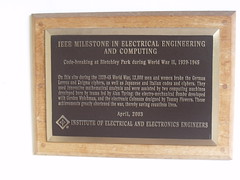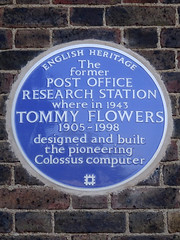Colossus
Commemorated on 3 plaques
IEEE Milestone in Electrical Engineering and Computing Code-breaking at Bletchley Park during World War II, 1939-45. On this site during the 1939-45 World War, 12,000 men and women broke the German Lorenz and Enigma ciphers, as well as Japanese and Italian codes and ciphers. They used innovative mathematical analysis and were assisted by two computing machines developed here by teams led by Alan Turing: the electro-mathematical Bombe developed with Gordon Welchman, and the electronic Colossus designed by Tommy Flowers. These achievements greatly shortened the war, thereby saving countless lives.
Bletchley Park House, Bletchley Park, Bletchley, United Kingdom where it designed
The former Post Office Research Station where Tommy Flowers (1905–1998) designed and built the pioneering Colossus computer
Chartwell Court, 151 Brook Road, Dollis Hill, London, United Kingdom where it sited
'Building 1' This building was erected in 1933 as the headquarters of the Post Office Engineering Department Research Station During the period 1933 - 1975 many innovative advances including 'Colossus' the worlds first programmable computer, were made in telecommunications and postal engineering on this site.
Chartwell Court, 151 Brook Road, Dollis Hill, London, United Kingdom where it sited




